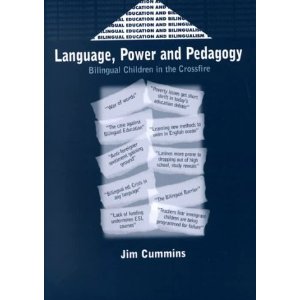Canadian curriculum and literacy theorist Jim Cummins discusses the problematic application of bilingual education, drawn from his experience in schools in California and francophone Canada.

Yet just down the road from these districts were dual language programs such as the Korean-English program in Cahuenga School (see Chapter 8). These programs, also termed ‘two-way bilingual immersion’, serve both English-dominant and Ll-dominant students with the goal of developing bilingualism and biliteracy among both groups. Despite the negative societal climate around bilingualism and bilingual education, these dual language programs have expanded significantly across the state during the past year, up from 95 in 1997-98 to 108 in 1998-99. …
I spoke in one of the breaks with a group of educators from one of the districts that operated a Spanish-English dual language program which appeared to be functioning very successfully for both groups of students. These educators wondered how the focus on language connections could be put into practice in the context of their dual language program. Formal English literacy instruction was not introduced until Grade 3 and there was some pressure to postpone it for another year, until Grade 4, in order to provide even more ‘psychological space’ for the minority language to develop to a higher level.
The discussion highlighted concerns about French immersion programs in Canada that I have had for more than 20 years (Cummins, 1977) and they appear highly relevant now in the context of dual language programs in the United States. … Among these are the following problematic assumptions:
- The two languages of instruction in bilingual programs should be kept rigidly separate.
- Models that provide exclusive or near-exclusive emphasis on the minority language in the early grades are superior to those that have more equal
- Instruction in the two languages (e.g. 50/50 models) and/or introduce literacy in both languages in Grade 1. • Transfer of literacy and concepts across languages will happen ‘automatically’ and thus as much instructional time as possible should be provided for the minority language to develop because the majority language will Took after itself and students will catch up rapidly after formal English instruction is introduced.
There is some substance to all three of these assumptions, but without qualifications they become dangerous half-truths. Certainly, languages of instruction should not be mixed in any kind of random way and it is important to provide students with appropriate oral and written models of each language. However, by not creating a context for bilingual language exploration in our classrooms we miss out on one of the most powerful tools that children in such programs have to develop their literacy and awareness of language. In French-English programs and Spanish-English programs, the cognate connections between the languages provide enormous possibilities for linguistic enrichment, but not if the program is set up to ensure that the two languages never meet. …
In the context of programs that aim to develop a high degree of bilingualism and biliteracy in non-threatened languages, I feel more comfortable with a program that unambiguously embraces bilingualism and biliteracy and takes steps to develop both languages at an early age. …
This is in accord with Hornberger’s (1989) discussion of cross-lingual transfer in the development of biliteracy. She notes that ‘highly efficient reading/writing ability in LI does not make up altogether for lack of knowledge of L2′ (1989: 286). Furthermore, she emphasizes that ‘the findings that a stronger first language leads to a stronger second language do not necessarily imply that the first language must be fully developed before the second language is introduced. Rather the first language must not be abandoned before it is fully developed, whether the second language is introduced simultaneously or successively, early or late, in that process’ (1989: 287). In short, some anxiety in relation to the strength of the majority language is certainly justified, but protection and development of the minority language can be better achieved by providing extensive and motivating opportunities for its oral and written use rather than focusing on erecting barricades against English.
Cummins, Jim. 2000. Language, Power and Pedagogy: Bilingual Children in the Crossfire. Toronto: Multilingual Matters. pp. 18-23. || Amazon || WorldCat
